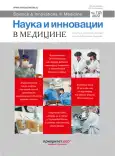Perimenopause and the state of diastolic function of the left ventricle in women
- Authors: Zelentsova L.R.1, Kuznetsov G.E.1, Tenchurina L.R.1, Shchetinina Y.S.1
-
Affiliations:
- Orenburg State Medical University
- Issue: Vol 7, No 2 (2022)
- Pages: 103-108
- Section: Cardiology
- URL: https://journal-vniispk.ru/2500-1388/article/view/89018
- DOI: https://doi.org/10.35693/2500-1388-2022-7-2-103-108
- ID: 89018
Cite item
Full Text
Abstract
Aim – to study the features of the diastolic function of the left ventricle, taking into account the gynecological history in women of perimenopausal age.
Material and methods. A single-stage cross-sectional study included 75 women aged 45 to 55 years. All women were examined, their anamnesis, including gynecological, was taken and gynecological status was established. Relying on echocardiography data, the women were divided into a group with normal left ventricular diastolic function and a group with diastolic dysfunction. Lipid and carbohydrate metabolism, the concentration of follicle-stimulating hormone were evaluated in all women.
Results. Study showed that women with detected type 1 diastolic dysfunction were older than women with normal diastolic heart function. In women with diastolic dysfunction, hypertension and negative metabolic indicators were more common; they were characterized by a greater number of pregnancies and abortions, if compared to women with unchanged heart function, in addition, they were more likely to be in early menopause.
Conclusion. Diastolic dysfunction is widespread in perimenopausal women, which is not always explained by traditional risk factors. There is a relationship between gynecological history and the development of diastolic dysfunction, but the pathogenetic mechanisms underlying this process in women remain unclear.
Full Text
##article.viewOnOriginalSite##About the authors
Liliya R. Zelentsova
Orenburg State Medical University
Author for correspondence.
Email: Lili2410@yandex.ru
post-graduate student, assistant of the Department of Internal medicine
Russian Federation, 6, Sovetskaya st., Orenburg, 460000Grigorii E. Kuznetsov
Orenburg State Medical University
Email: girshkuz@mail.ru
ORCID iD: 0000-0001-6773-6184
PhD, Professor, Department of Internal medicine
Russian Federation, 6, Sovetskaya st., Orenburg, 460000Lerida R. Tenchurina
Orenburg State Medical University
Email: girshkuz@mail.ru
ORCID iD: 0000-0002-5237-1044
PhD, Associate professor, Department of Internal medicine
Russian Federation, 6, Sovetskaya st., Orenburg, 460000Yuliya S. Shchetinina
Orenburg State Medical University
Email: koto-yuliya@yandex.ru
PhD, Associate professor, Department of Obstetrics and gynecology
Russian Federation, 6, Sovetskaya st., Orenburg, 460000References
- Shapovalova EB, Maksimov SA, Artamonova GV. Gender differences of cardiovascular risk. Russian Journal of Cardiology. 2019;(4):99-104. (In Russ.). [Шаповалова Э.Б., Максимов С.А., Артамонова Г.В. Половые и гендерные различия сердечно-сосудистого риска. Российский кардиологический журнал. 2019;24(4):99-104]. doi: 10.15829/1560-4071-2019-4-99-104
- Savonito S, Ferri LA, Colombo D. Perimenopause vasomotor symptoms, coronary atherosclerosis and risk of myocardial infarction during menopause: the cardiologist’s perspective. Menopause review. 2018;17(2):53- 56. doi: 10.5114 / pm.2018.77301
- Redfield MM, Jacobsen SJ, Burnett JC, et al. Burden of systolic and diastolic ventricular dysfunction in the community: appreciating the scope of the heart failure epidemic. JAMA. 2003;289:194-202. doi: 10.1001 / jama.289.2.194
- Drapkina OM, Palatkina LO. New accents in the study of the pathogenesis of chronic heart failure with preserved ejection fraction: focus on markers of inflammation. Rational pharmacotherapy in cardiology. 2014;10(3):317-321. (In Russ.). [Драпкина О.М., Палаткина Л.О. Новые акценты в изучении патогенеза хронической сердечной недостаточности с сохраненной фракцией выброса: фокус на маркеры воспаления. Рациональная фармакотерапия в кардиологии. 2014;10(3):317-321].
- Tadic M, Cuspidi C, Frydas A, Grassi G. The role of arterial hypertension in development heart failure with preserved ejection fraction: Just a risk factor or something more? Heart Fail Rev. 2018;23:631-639. doi: 10.1007/s10741-018-9698-8
- van Heerebeek L, Franssen CP, Hamdani N, et al. Molecular and cellular basis for diastolic dysfunction. Curr Heart Fail Rep. 2012; 9(4):293-302. doi: 10.1007 / s11897-012-0109-5
- Kass DA, Bronzwaer JG, Paulus WJ. What mechanisms underlie diastolic dysfunction in heart failure? Circ Res. 2004;94:1533-42. doi: 10.1161/01.RES.0000129254.25507.d6
- Seryozhina EK, Obreban AG. The effect of age-and-sex hormonal changes on the formation and development of heart failure. Russian Journal of Cardiology. 2020;25(6):3710. (In Russ.). [Сережина Е.К., Обрезан А.Г. Влияние половозрастных гормональных изменений на формирование и развитие сердечной недостаточности. Российский кардиологический журнал. 2020;25(6):3710]. doi: 10.15829/1560-4071- 2020-3710
- Gori M, Lam CS, Gupta DK, et al. PARAMOUNT Investigators. Sex-specific cardiovascular structure and function in heart failure with preserved ejection fraction. Eur J Heart Fail. 2014;16:535-542. doi: 10.1002/ejhf.67
- Yoneyama K, Gjesdal O, Choi EY, et al. Age, sex, and hypertension-related remodeling influences left ventricular torsion assessed by tagged cardiac magnetic resonance in asymptomatic individuals: the multi-ethnic study of atherosclerosis. Circulation. 2012;126:2481-2490. doi: 10.1161/CIRCULATIONAHA.112.093146
- Tadic M, Cuspidi C, Plein S, et al. Sex and heart failure with preserved ejection fraction: from pathophysiology to clinical studies. J Clin Med. 2019;8(6):792. doi: 10.3390/ jcm8060792
- Li S, Gupte AA. The role of estrogen in cardiac metabolism and diastolic function. Methodist Debakey Cardiovasc J. 2017;13:4-8. doi: 10.14797/mdcj-13-1-4
- Subramanya V, Zhao D, Ouyang P, et al. Sex hormone levels and change in left ventricular structure among men and post-menopausal women: The Multi-Ethnic Study Of Atherosclerosis (MESA). Maturitas. 2018;108:37-44. doi: 10.1016/j.maturitas.2017.11.006
- Eaton CB, Pettinger M, Rossouw J, et al. Risk factors for incident hospitalized heart failure with preserved versus reduced ejection fraction in a multiracial cohort of postmenopausal women. Circ Heart Fail. 2016;9:e002883. doi: 10.1161/CIRCHEARTFAILURE.115.002883
- Mengden T, Weber T. "Little Old Ladies’ Heart" – Ventriculo-arterial coupling in women with isolated systolic hypertension and diastolic dysfunction. Dtsch Med Wochenschr. 2019;144:561-567. doi: 10.1055/a-0757-5859
- Chung E, Yeung F, Leinwand LA. Akt and MAPK signaling mediate pregnancy-induced cardiac adaptation. J Appl Physiol (1985). 2012;112:1564-1575. doi: 10.1152/japplphysiol.00027.2012
- Keskin M, Avşar Ş, Hayıroğlu Mİ, et al. Relation of the number of parity to left ventricular diastolic function in pregnancy. Am J Cardiol. 2017;120:154-159.
- Wu P, Haththotuwa R, Kwok CS, et al. Preeclampsia and future cardiovascular health: a systematic review and meta-analysis. Circ Cardiovasc Qual Outcomes. 2017;10:e003497. doi: 10.1161/CIRCOUTCOMES. 116.003497
- Melchiorre K, Sharma R, Thilaganathan B. Cardiovascular implications in preeclampsia: an overview. Circulation. 2014;130:703-714. doi: 10.1161/CIRCULATIONAHA.113.003664
Supplementary files







